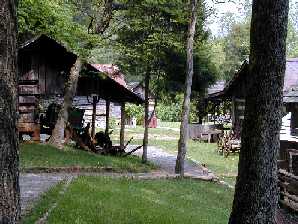
Tennessee and Kentucky, May 5-8, 2000
The Mobile Steam Society of Oak Ridge, Tennessee has hosted a spring meeting, the weekend before Mother's Day for the last 18 years. Now that we live in Illinois, it is actually possible to drive there in one day to see what goes on there. We drove down on Wednesday through the farms of southeastern Illinois, across the parkways of Kentucky which were very lush in the spring greens, and south through the depressed coal mining areas of the Cumberland Mountains to Oak Ridge.Since the meeting schedules were mostly in the mornings, we had some afternoons to tour around, and found the Museum of Apalachia on Thursday afternoon. Most private museum tourist traps would be at least worth a walk through the gift shop, but this one had been put together by a master, and was probably worth two days of looking, if we had the time. We actually returned two days later to buy some more books and things, and read the books into the evenings--much more entertaining than the steam car topics. The author and co-founder of the museum is a most engaging and sensitive writer who clearly appreciates the people and history of the mountains. He is able to give it back to us freely in his books, and, most delightfully, in the really deep descriptions of the thousands of museum displays. An item on display may only have a little bit about its date and maker, but the tag will go on to some length about the owner and his use of the object. Although the visitor is cautioned not to handle the objects, even the most rare or personal items are within arm's reach and provide the visitor with an object lesson in self-restraint.

These were not museum replicas, but original barns, school, a church and cabins, full of the furniture and objects which would have been used in them, most arranged by people who had lived in them or their descendants.Scattered through the cabins were fine mountain musicians who had grown up with the sounds of mountain music as part of thieir lives. This was not country and western commercial stuff, but real home-grown bluegrass flavor music. One old fiddler was the co-founder of the museum itself. He asked for the name of a tune, and I gave him "Arkansas Traveler," and got back a quick once-through playing, then the history of the tune, the stories he swapped with the last music professor that asked him about it, a verse by verse playing and background on the details of the story that went with the tune, and information on the 1925 record that both he and the professor had first heard the tune on. No, wait, there was more. . . . We broke away eventually. We recognized the names of Atkins and Wyrick among the musicians.
.
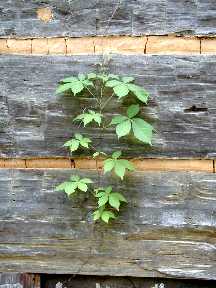 |
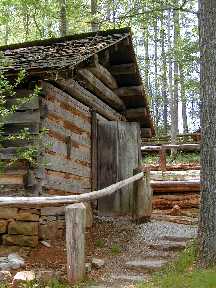 |
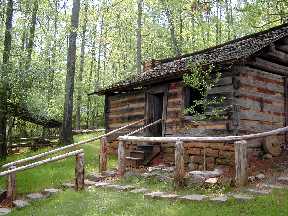
The school house was raised on a higher foundation than most of the other buildings and had a feathery vine growing up to the left of the front door.
.
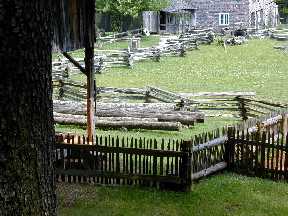 |
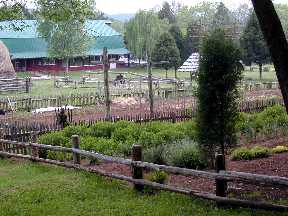 |
The split rail fences were only one of the reminders that virtually all of the items used by the mountain people were not only made locally, but by themselves.The gardens were especially planted with things the locals would have used. Some of the varieties of vegetables and livestock are found no where else. The "fainting goats" drop over cold if startled. This is obviously not an advantage in keeping them alive with predators or even the neighbor's dogs around, but it is unique breed to the mountains.
.
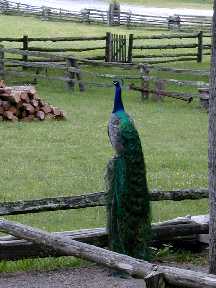
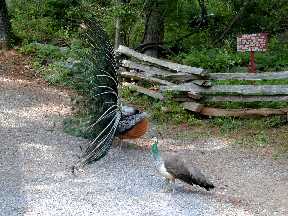 |
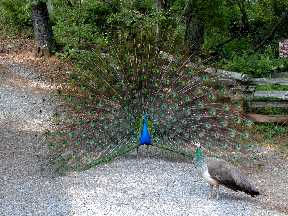 |
Who knows if peacocks were found in the hills in the early days, but it was interesting to see several pair in the yards.
.
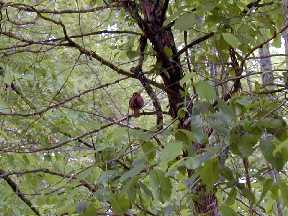
A tiny wren sang so clearly and loud that we spend a minute looking through the trees for a source of the songs. We were amazed to find such music coming from so small and bold a bird.On the way back over the Cumberland Mountains on I-75, we again came across the deep vertical road cuts. The native limestone was undisturbed by geological action from its level courses.
.
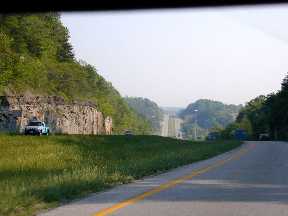
On into Kentucky, we finally saw some horses and horse farms with the kind of white fences we had expected.
.
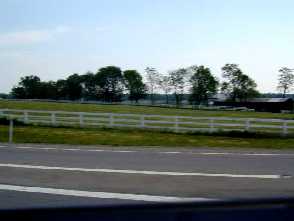 |
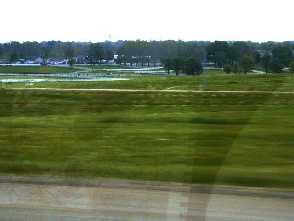 |
Driving hard to the north on I-75 to avoid a line of severe thunderstorms, we reached the Ohio River just west of Cincinnati, zigzagged across as the highway led us through Ohio for about ten minutes, then on across Indiana on I-74, making it a two-interstate trip home.
This page powered by, created May 7, 2000. Copyright © 2000 Karl A. Petersen.